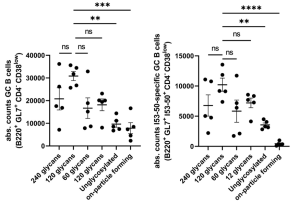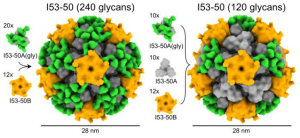A group from Koch Institute for Integrative Cancer Research, Massachusetts Institute of Technology, Cambridge, MA 02139, USA, etc. has reported on a method using glyco-antigen expressing nanoparticles (NPs) as vaccines.
https://pubmed.ncbi.nlm.nih.gov/35021101/
Authors recently reported that glycosylated HIV-immunogen-bearing nanoparticles accumulate within follicles in a process mediated by mannose-binding lectin (MBL), which triggers complement deposition on the nanoparticle surface, transport to follicular dendritic cells (FDCs), and enhanced germinal center (GC) and serum antibody responses relative to non-accumulating nanoparticles.
Titrating the mean glycosylation of these particles from zero to 240 high-mannose glycans per NP resulted in steady increases in in vitro MBL binding as well as in vivo FDC localization. However, it starts to decrease with increasing the glycan density further (as shown below). These experiments provide an estimate of the minimal glycan patch density required to initiate MBL binding, which for the model ∼25 nm particles studied here was 2.1 × 10−3 mannose patches/nm2, corresponding to a mean separation of ∼21 nm between patches.
< a href="https://www.emukk.com/WP/wp-content/uploads/2022/01/glycosylated-NP_immunization.png">

